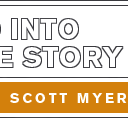One of the reasons I recommend this script to my students is it falls into a category of what I call Unconventional Conventional Screenplays. Of course, there’s the spectacle of the multiverse, hot dog fingers, the universe as a bagel, and on and on, all the story’s wonderfully surprising plot events, so many of them feeling quite unconventional.
What I want to focus on is the structure of the plot because it’s both unconventional and conventional.
The Wang family is introduced in conventional fashion in the sense that we meet them in their ordinary world during the first 15 pages. We meet the story’s key characters in this sequence, some of the key areas of conflict: Evelyn and Joy’s disharmony, Waymond seeking a divorce, Joy’s secret romance with Becky, Evelyn’s bitter relationship with her father Gong Gong, the laundromat’s failing business). The visit to the tax office feels like the Act One midpoint.
Up to this point, the structure of the plot feels conventional.
Then the Call to Adventure: The first time Alpha Waymond appears. That elevator scene ends on 20. After the introduction of Deirdre, pretty much the rest of the script is breathless action with some notable exceptions (e.g., the rocks). That is unconventional. Normally, after an action sequence or extended series of action scenes, there is some downtime allowing the characters (and the audience) to process what has transpired. There are those moments, but most of them are merely a slowing of action.
Another plot choice which feels unconventional: I would argue that the actual Act One end doesn’t happen until 35-40 for that is when Evelyn is told by Alpha Waymond she is the only one who can stop the evil Jobu. That establishes the Protagonist’s goal: somehow deal with Jobu (who Evelyn has learned is her daughter Joy). In my view, Act One locks down all major narrative elements and character dynamics, setting up the rest of the story. That this happens by 40 means this is a long first act.
As I have stated many, many times, I don’t believe in screenwriting rules and I certainly don’t believe that the “this needs to happen by that page” mindset is how we should think as we go about structuring the story’s plot. The fact this act-ending revelation happens on 40 is no problem for me. The story works as we get swept up in the action and learning about the Alphaverse and other universes.
But I’m pretty sure a typical reader, if tasked with providing coverage on this project, would have dinged the script for having a first act which is too long.
Not me. It may be unconventional, but it works.
Also the fact the script clocks in at 125 is unconventional in a Hollywood development world where 105 is the new 120. Here again, it doesn’t bother me in the slightest because the story works and I care about the characters.
So what’s conventional about the plot? Lots of things:
• The Protagonist has a clear goal which inevitably leads to a Final Struggle between Evelyn and Jobu.
• The first half of Act Two is largely about Evelyn getting knocked about, scrambling to “find her footing” in this new reality of multiple universes in which she exists.
• The second half of Act Two depicts how Evelyn does find her foothold and begins to master the power of the multiple universes.
• There are key subplots (my principle: Subplot = Relationship): Evelyn / Joy, Evelyn / Wamond, Evelyn / Gong Gong, Evelyn / Deirdre
All of this is conventional. Plus, perhaps the most conventional aspect of the story: The Protagonist has a Disunity to Unity character arc.
That’s a topic I’ll get into in the next article in this series.
